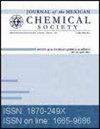辣椒果实中的抗坏血酸:生物合成、积累及其含量影响因素
IF 0.8
4区 化学
Q3 CHEMISTRY, MULTIDISCIPLINARY
引用次数: 0
摘要
摘要辣椒果实是生物活性化合物的重要来源,如辣椒素、类胡萝卜素、抗坏血酸、类黄酮、酚类化合物和矿物质。从它们中,辣椒果实合成并积累了重要浓度的抗坏血酸(AsA)(也称为维生素C)。AsA具有自由基清除剂和有效抗氧化剂的重要作用。在植物中,AsA对维持细胞内稳态起着至关重要的作用,而在动物中,AsA对细胞代谢也很重要。由于人类和一些动物物种不能合成维生素C,他们必须从植物性食物中获取,而辣椒水果是摄取维生素C的绝佳选择。本文综述了辣椒果实中维生素C的生物合成、积累、农业实践和采后贮藏对维生素C的影响等方面的最新生物学研究进展。Resumen。辣椒具有多种重要的生物活性物质(辣椒素、类胡萝卜素、ácido ascórbico、类黄酮、辣椒素fenólicos和矿物质)。De samatos, el chile continene concentraciones muy importantes De ácido ascóbico (AsA) (tamamsamatos conocido como vitamin C). el samatene unimportant paper en la eliminación De radicales libres是一种有效的抗氧化剂。在植物中,el - AsA是维持体内平衡的关键功能细胞,在动物中,el - AsA是非常重要的代谢细胞。debedo a que los humanos y algunes species es animales son incapaces de sinintetizarlo, ello debeen adquirilo a partite de alimentos de origen vegetal, siendo los frutos de chile una excelente fuente de vitamina C. En esta revisión, se integran los advances más recies acerca de la investigación de la vitamina C, su ruta de biosíntesis, su contenido En frutos de chile y, finende。不同因素对辣椒果实生长的影响agrícola与辣椒果实生长过程的关系本文章由计算机程序翻译,如有差异,请以英文原文为准。
Ascorbic Acid in Chili Pepper Fruits: Biosynthesis, Accumulation, and Factors Affecting its Content
Abstract. Chili pepper fruits are important sources of bioactive compounds e.g., capsaicinoids, carotenoids, ascorbic acid, flavonoids, phenolic compounds, and minerals. From them, chili pepper fruits synthesize and accumulate important concentrations of ascorbic acid (AsA) (also known as vitamin C). AsA has an important role as a free-radical scavenger and as an effective antioxidant. In plants, AsA develops crucial functions for the homeostasis maintenance of the cells, whereas, in animals, AsA is very important for cellular metabolism too. Because of humans and some animal species are incapable of synthesizing AsA, they must acquire it from vegetable food, and chili pepper fruits represent an excellent option for vitamin C uptake. In this review, we integrate the latest biological advances of the research about vitamin C in chili pepper fruits including biosynthesis, accumulation, and the effects of agricultural practices and postharvest storage.
Resumen. El chile es una fuente muy importante de compuestos bioactivos (capsaicinoides, carotenoidess, ácido ascórbico, flavonoides, compuestos fenólicos y minerales). De éstos, el chile contiene concentraciones muy importantes de ácido ascóbico (AsA) (también conocido como vitamina C). El AsA tiene un importante papel en la eliminación de radicales libres y es un antioxidante muy efectivo. En plantas, el AsA lleva a cabo funciones cruciales para el mantenimiento de la homeostasis celular, mientras que, en animales, el AsA es muy importante para el metabolismo celular. Debido a que los humanos y algunas especies animales son incapaces de sintetizarlo, ellos deben adquirirlo a partir de alimentos de origen vegetal, siendo los frutos de chile una excelente fuente de vitamina C. En esta revisión, se integran los avances más recientes acerca de la investigación de la vitamina C, su ruta de biosíntesis, su contenido en frutos de chile y, finalmente, el efecto de diferentes factores como el manejo agrícola y el procesamiento de frutos de Capsicum sobre el contenido de AsA.
求助全文
通过发布文献求助,成功后即可免费获取论文全文。
去求助
来源期刊
CiteScore
2.00
自引率
0.00%
发文量
0
审稿时长
6-12 weeks
期刊介绍:
The Journal of the Mexican Chemical Society (J. Mex. Chem. Soc.) is a scientific, blind, peer reviewed, and open access, free of charge publication that covers all areas of chemistry and its sub-disciplines (i.e. medicinal chemistry, natural products, electrochemistry, material science, computational chemistry, organic chemistry, bionirganic chemistry, etc). It is devoted to facilitating the worldwide advancement of our understanding of chemistry. It will primarily publish original contributions of research in all branches of the theory and practice of chemistry in its broadest context as well as critical reviews in active areas of chemical research where the author has published significant contribution. The J. Mex. Chem. Soc. is a quarterly publication which language of submission and publication is English. To be suitable for publication in J. Mex. Chem. Soc., manuscripts must describe novel aspects of chemistry, high quality of results and discussion an excellent bibliographic support, and contribute to the development of the field. Routine or incremental work are not suitable for publication in J. Mex. Chem. Soc. Authors are encouraged to send contributions in electronic form. Our online submission system guides you stepwise through the process of entering your article details and uploading your files.

 求助内容:
求助内容: 应助结果提醒方式:
应助结果提醒方式:


